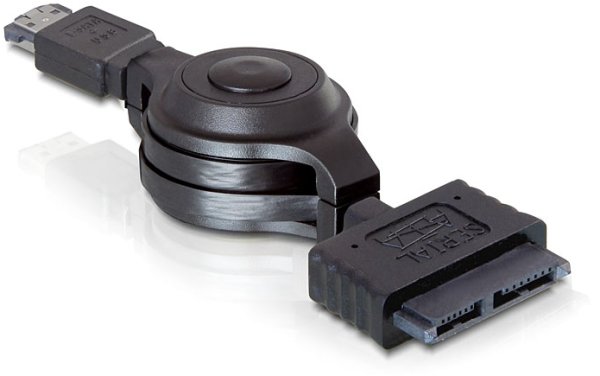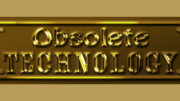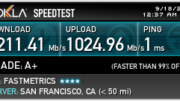Does it seem like this alphabet soup is out of control? Because SATA was hard enough to swallow. If you trace the origins of this acronym all the way back, you’ll learn that the middle “AT” doesn’t really stand for anything. It refers all the way back to the original 1980s IBM PC/AT, and IBM only half-heartedly claimed their “AT” stood for anything.
SATA took over as the dominant technology for hard drives several years ago because it’s fast and the connector’s pretty small. Not small enough though, and SATA retains its predecessors’ need for a separate power cord. When you wanted to use an external SATA drive, you still had to power it, and the term “eSATA” (the “e” nominally standing for “external” was coined for a regular SATA data connection that protruded from the back of a device. DIRECTV has used this connector for years to allow the use of an external drive.
Now, there’s eSATAp. You have a lower case letter at the beginning and the end. When will the madness end?
Not than anyone can actually even agree to call it eSATAp, either. You could call it Power-over-eSATA, or eSATA/USB combo, or a whole bunch of other stuff. No one can agree, and that’s because it’s not a real standard. But I’ll explain that momentarily.
The purpose of eSATAp, or whatever you want to call it, is to give you one connector that will let you connect a USB hard drive or an eSATA one, and provide enough power to run it. The connector is shaped so that all the standard pins of an SATA cable fit as well as all the ones of a USB cable, and that’s a neat little feat of engineering. It’s also designed to deliver 5 volts through the line to power the drive. Some of them, designated eSATApd — will it never end — can deliver 12 volts.
An eSATAp cable splits out the power and data parts of the thing so you can connect it to a traditional SATA drive, making it easy to repurpose any of those old drives you have laying around.
It sounds like a really cool thing if you think about it, but there’s that one problem I mentioned earlier… it’s not approved by anyone. The USB people and the SATA people both have “consortiums” that set the exact standards used for their cables. Neither consortium wants to share, and there are rules in both their books that say that their connector can’t share with anyone else’s. That means a hybrid USB/SATA connector is flat-out illegal in their opinions. That leaves eSATAp without a clear future, although personally I think it’s a cool piece of engineering that every manufacturer should adopt. None of them will though, not if the connector is unapproved.
That leaves eSATAp in a sort of netherworld. There are a few companies that use the connector and a few companies make cables that convert from eSATAp to regular SATA, but so far it’s just another good idea that may never take off.





